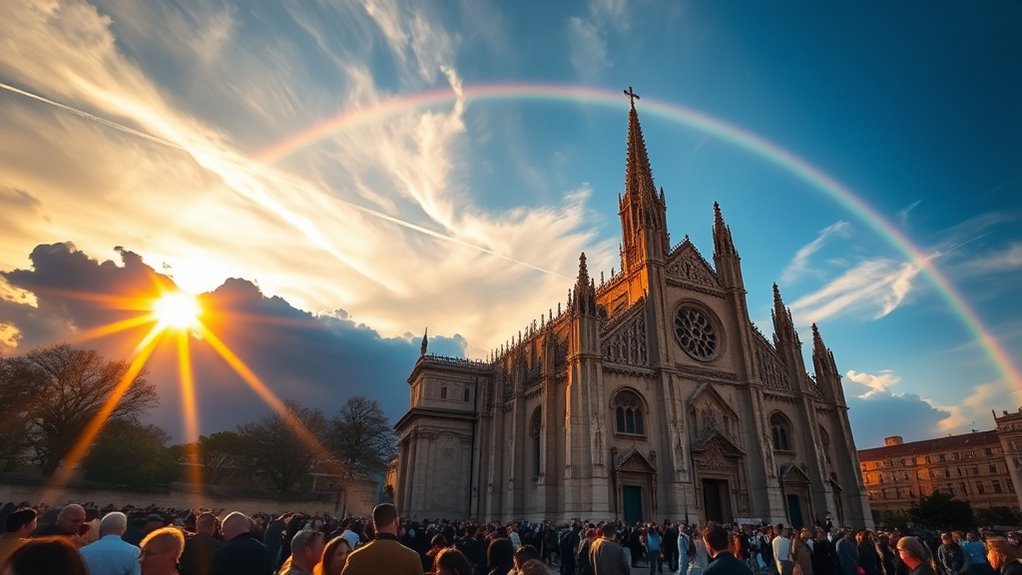Miracles can still happen today, but whether you see them as divine signs or coincidences depends on your beliefs and perspective. Historically, many regarded miracles as proof of higher powers, while scientists often offer natural explanations like coincidences or psychological factors. Personal stories and faith influence how people perceive extraordinary events. If you’re curious, exploring these different views may help you understand how miracles are viewed in today’s world.
Key Takeaways
- Miracles are viewed differently depending on individual faith, cultural beliefs, and personal experiences.
- Scientific explanations often attribute claimed miracles to natural causes or psychological factors.
- Modern miracle claims frequently involve unexplained recoveries or coincidences interpreted as divine signs.
- Evidence for miracles today varies; credible cases require extraordinary, well-documented events that defy natural laws.
- Belief in miracles remains subjective, influenced by spirituality, faith, and personal interpretation of events.
Historical Perspectives on Miracles and Their Significance

Throughout history, people have regarded miracles as extraordinary events that affirm divine power and intervention. In the historical context, societies often saw miracles as signs from higher powers, reinforcing religious beliefs and moral codes. Cultural interpretations varied widely: some viewed miracles as direct acts of gods or saints, while others saw them as symbols of spiritual truth or divine favor. These events often strengthened community bonds and inspired faith during uncertain times. Throughout centuries, stories of miraculous healings, visions, and wonders became central to religious traditions and texts. The significance of miracles shifted with cultural perspectives, shaping how societies understood divine involvement in human affairs. By examining these historical perspectives, you gain insight into how different cultures have interpreted extraordinary events as meaningful and divine.
Scientific Explanations and Skeptical Views

Scientific explanations and skeptical views often challenge the idea that miracles are acts of divine intervention, instead attributing these events to natural causes or psychological factors. Many believe that what appears as supernatural phenomena can be explained through science, such as spontaneous remission or psychological suggestibility. Scientific skepticism questions the validity of miracle claims, emphasizing that extraordinary events often have overlooked natural explanations. Understanding these perspectives helps you evaluate claims critically. Here’s a visual overview:
| Explanation Type | Example | Common Skeptical View |
|---|---|---|
| Natural Causes | Healing through medicine | Events have scientific basis |
| Psychological Factors | Mass hysteria, hallucinations | Beliefs influence perception |
| Misinterpretation | Coincidences mistaken for miracles | Lack of evidence for supernatural phenomena |
| Confirmation Bias | Seeing what you want to see | Overlooking natural explanations |
This view prioritizes scientific inquiry over supernatural assumptions.
Contemporary Claims and Personal Testimonies

Have you ever encountered a personal story or claim of a miracle that seemed too extraordinary to ignore? Many people share modern miracle claims rooted in miracle symbolism, where signs or events are seen as divine intervention. These testimonies often involve healings, unexplained recoveries, or coincidences that believers interpret as evidence of the supernatural. Personal testimonies can be powerful, resonating deeply within communities and inspiring faith. While skeptics may dismiss these stories as coincidence or psychological effects, others see them as genuine signs that miracles still happen today. These contemporary claims often serve as personal proof of the divine’s presence, fueling ongoing debates about whether miracles are real or simply meaningful symbols.
The Role of Faith and Spirituality in Recognizing Miracles

Faith and spirituality play a pivotal role in how you interpret and recognize miracles, shaping your perception of extraordinary events as divine signs. When you believe in divine intervention, you’re more likely to see seemingly impossible moments as acts of a higher power. Spiritual awakening can open your eyes to these signs, transforming ordinary occurrences into meaningful miracles. Your faith provides a lens through which you interpret events, making connections that others might overlook. This spiritual perspective deepens your sense of wonder and trust in the unseen, guiding you to perceive miracles even in everyday life. Ultimately, your level of faith influences whether you view extraordinary happenings as divine acts or mere coincidences.
Evaluating the Evidence: Are Miracles Still Possible Today?

Many people wonder whether there’s credible evidence to support the existence of miracles today. A miracle definition typically describes an extraordinary event that defies natural laws, often attributed to divine intervention. When evaluating the evidence, you must consider the difference between faith versus evidence. Faith relies on trust and spiritual conviction, while evidence demands tangible proof. Although many claim to have witnessed miraculous events, skeptics argue that these stories lack verifiable data. To determine if miracles are still possible today, you need to examine documented cases critically, looking for consistent, credible evidence. Ultimately, whether you see miracles as real depends on your willingness to balance faith with objective evaluation of the available evidence.
Frequently Asked Questions
Can Miracles Be Scientifically Proven Beyond Doubt?
You wonder if miracles can be scientifically proven beyond doubt. While faith confirmation often guides belief, empirical validation remains challenging because miracles are typically spontaneous and personal. Scientific methods require repeatability and measurable evidence, which miracles rarely provide. So, although some claim to have seen miracle-like events, you may find it hard to achieve definitive proof that convinces everyone, leaving the question of their scientific validity open-ended.
Do Different Religions Interpret Miracles Differently?
You’ll find that different religions interpret miracles through faith interpretations shaped by their unique doctrinal differences. While some see miracles as divine acts confirming their beliefs, others view them as symbolic stories. These varying perspectives influence how believers understand and accept miraculous events, highlighting the diversity in religious doctrines. Ultimately, your interpretation depends on your faith background and how you perceive the role of divine intervention within your spiritual framework.
Are Miracles More Common in Certain Cultures or Regions?
You might notice that miracles seem more frequent in certain cultures or regions due to cultural beliefs and regional practices that shape perceptions of the supernatural. In some areas, traditions emphasize divine interventions or spiritual events, making miracles more visible and accepted. These cultural influences influence how people interpret extraordinary occurrences, leading you to see miracles as more common where regional practices foster strong spiritual or religious experiences.
How Do Personal Biases Influence Belief in Miracles?
Your faith perception greatly shapes how you see miracles, and bias influence plays a key role. If you’re open-minded, you’re more likely to interpret events as miraculous. Conversely, personal biases can cause you to dismiss or overlook miracles, based on your beliefs or skepticism. Recognizing how bias influence affects your perceptions helps you understand why some see miracles today while others don’t. Your mindset ultimately shapes your belief in the extraordinary.
What Psychological Factors Contribute to Perceived Miracles?
Imagine faith perception as a lens, shaping how you see extraordinary events. Psychological factors like cognitive biases, such as confirmation bias, make you more likely to interpret unlikely coincidences as miracles. Your mind seeks meaning, especially in times of uncertainty, leading you to perceive miraculous moments. These subconscious processes influence your beliefs, making it seem like miracles happen today, even if they’re rooted in perception rather than reality.
Conclusion
You might be surprised to learn that over 80% of people worldwide believe in miracles today. While science offers explanations, many still experience awe and wonder through personal testimonies and spiritual moments. Miracles may not fit into scientific categories, but their impact on faith and hope is undeniable. So, whether you see them as supernatural events or powerful signs, one thing’s clear: miracles continue to inspire and challenge our understanding of what’s possible.










